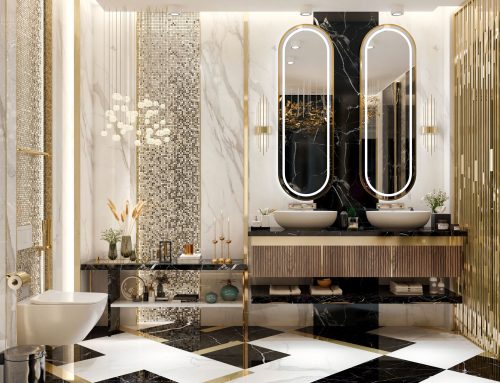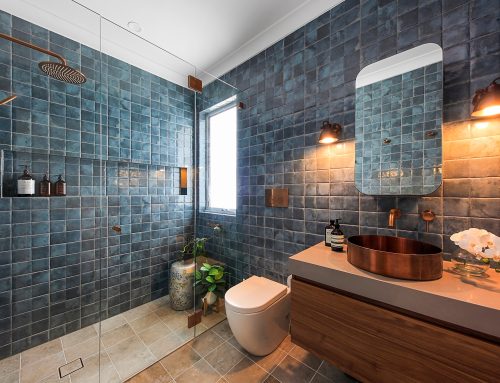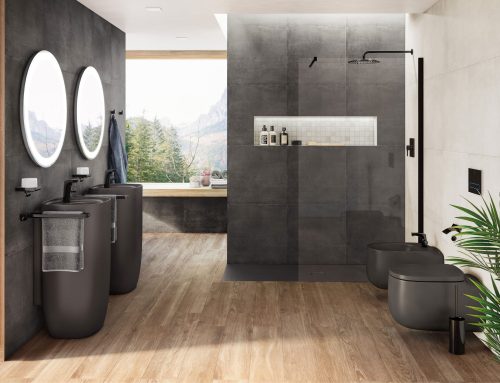Transforming your bathroom into a spa-like retreat is a rewarding endeavor, offering a personal sanctuary where you can unwind and rejuvenate. This comprehensive guide explores various elements that contribute to creating such a haven, including soaking tubs, rain showers, steam rooms, ambient lighting, natural materials, and smart technology. Each section delves into the details of these features, providing practical advice and inspiration to help you design the bathroom of your dreams.
The Essence of a Spa-Like Bathroom
Understanding the essence of a spa-like bathroom is crucial before diving into specific features. Such a space embodies tranquility, luxury, and relaxation, engaging the senses to promote well-being. Key principles include simplicity and minimalism, natural elements, luxury fixtures, ambient lighting, and sensory experiences. A clutter-free environment fosters a sense of calm, while minimalist design with clean lines and a simple color palette enhances openness and serenity. Incorporating natural materials like wood, stone, and plants creates a connection to nature, inherently calming. High-end fixtures like soaking tubs, rain showers, and steam rooms elevate the bathroom experience, providing a touch of indulgence. Thoughtful lighting design can dramatically affect the ambiance, with soft, adjustable lighting enhancing relaxation. Engaging the senses with soothing scents, calming sounds, and tactile materials creates a truly immersive spa experience.
Soaking Tubs: The Heart of Relaxation
Soaking tubs often serve as the centerpiece of a spa-like bathroom. Their deep, ergonomic design allows for full immersion, promoting relaxation and stress relief. When choosing a soaking tub, consider various types, materials, placement, and ways to enhance the soaking experience.
- Types of Soaking Tubs include freestanding tubs, built-in tubs, Japanese soaking tubs, air tubs, and whirlpool tubs. Freestanding tubs, not attached to walls, offer a sculptural quality, available in various materials like acrylic, cast iron, and stone resin. Built-in tubs, installed against a wall or within a deck, save space and integrate seamlessly into the bathroom layout, often featuring built-in storage or seating. Japanese soaking tubs, or Ofuro tubs, are deeper than standard tubs, providing a more immersive experience, ideal for smaller spaces. Air tubs and whirlpool tubs incorporate jets producing a massaging effect, though requiring more maintenance than traditional soaking tubs.
- Material Choices affect the tub’s appearance, durability, and maintenance needs. Acrylic tubs are lightweight, versatile, and retain heat well, while cast iron tubs are durable, excellent at retaining heat, but heavy. Stone resin tubs mimic the look and feel of natural stone, are lighter, more affordable, and resistant to scratches. Copper and brass tubs add a unique, luxurious touch, with copper offering excellent heat retention and antimicrobial properties but requiring regular maintenance to prevent tarnishing.
- Placement and Installation of your soaking tub should be carefully considered. Freestanding tubs work well as focal points, positioned in the center of the room or near a window for a dramatic effect. Built-in tubs can be installed in corners or alcoves to maximize space. Ensure the plumbing and flooring support the tub’s weight, especially for heavy materials like cast iron or stone. Professional installation is often recommended for proper setup.
- Enhancing the Soaking Experience can involve bath caddies and trays for holding candles, books, or wine, bath pillows for neck and head support, aromatherapy with essential oils or bath salts, and heated towel racks for toasty, ready-to-use towels after a bath.
Rain Showers: Immersive and Invigorating
Rain showers replicate the sensation of standing in a gentle rain, providing a soothing and immersive experience. They are an essential element of a spa-like bathroom, offering both aesthetic appeal and practical benefits.
- Types of Rain Showerheads include ceiling-mounted, wall-mounted, and dual showerheads. Ceiling-mounted showerheads create a true rain-like experience with water cascading directly from above but require more complex plumbing and installation. Wall-mounted showerheads are easier to install, attached to an adjustable arm, allowing positioning at the desired height and angle. Dual showerheads combine a rain showerhead with a handheld option for versatility.
- Material and Finish options for rain showerheads include chrome, brushed nickel, oil-rubbed bronze, and matte black. Chrome is durable and easy to clean, brushed nickel offers a soft, matte finish resistant to water spots and fingerprints, oil-rubbed bronze adds vintage or rustic charm but requires more maintenance, and matte black makes a bold statement, pairing well with minimalist or industrial design themes.
- Installation Considerations involve ensuring adequate water pressure, shower size, and height and angle adjustments for maximum comfort. Rain showers work best in larger enclosures that allow space for the water to fall freely.
- Enhancing the Rain Shower Experience can include thermostatic controls for consistent water temperature, LED lighting for a visual element, aromatherapy showerheads for infusing water with essential oils, and integrating Bluetooth speakers for calming music or nature sounds.
Steam Rooms: Ultimate Relaxation and Detoxification
Steam rooms offer a luxurious and healthful addition to any spa-like bathroom. The warm, moist environment promotes relaxation, detoxification, and respiratory health. Creating a home steam room involves careful planning and consideration of specific elements.
- Benefits of Steam Rooms include relaxation and stress relief, detoxification, respiratory health, and improved circulation. The warmth and humidity relax muscles and ease tension, while sweating helps eliminate toxins, improving skin health and circulation. The moist air clears nasal passages, relieves congestion, and enhances breathing, while heat increases blood flow, aiding muscle recovery and cardiovascular health.
- Designing a Home Steam Room involves determining the space and size based on available space and the number of users, choosing durable materials like tile, glass, and stone, and ensuring comfortable, heat-resistant seating. The steam generator is the heart of the steam room, requiring selection based on room size and features like quick-start, remote control, and aromatherapy options.
- Installation Considerations include proper waterproofing to prevent moisture damage, adequate ventilation to prevent mold and mildew, and ensuring safe plumbing and electrical connections by hiring professionals. Control panels should be installed inside and outside the steam room for temperature, steam output, and additional features like lighting and music adjustments.
- Enhancing the Steam Room Experience can involve aromatherapy, chromotherapy with colored LED lights, integrating music and sound systems, and installing towel warmers for warm, dry towels after a steam session.
Ambient Lighting: Setting the Mood
Lighting plays a crucial role in creating a spa-like atmosphere. The right lighting enhances relaxation, highlights key features, and sets the overall mood of the bathroom.
- Types of Lighting include task lighting for specific tasks, ambient lighting for overall illumination, accent lighting to highlight features, and decorative lighting for style and personality. Combining these types creates a balanced and versatile lighting scheme.
- Lighting Techniques like layered lighting combine different types for a versatile scheme, dimmers adjust brightness to create different moods, maximizing natural light enhances the sense of space, and LED lighting provides energy-efficient, long-lasting options for subtle, ambient effects.
- Enhancing the Lighting Experience can involve adding candles for a soft, flickering light, using lanterns and fairy lights for a whimsical touch, integrating mirror lighting for even, flattering illumination, and employing smart lighting systems controlled via smartphone or voice assistant for custom lighting scenes.
Natural Elements: Connecting with Nature
Incorporating natural elements into your bathroom design creates a calming, spa-like environment. Natural materials, plants, and water features contribute to tranquility and well-being.
- Natural Materials like wood, stone, bamboo, and cork add warmth, texture, and a luxurious touch. Wood can be used for vanities, shelving, or accent walls, while stone surfaces like marble, granite, and slate provide a timeless look. Bamboo is a sustainable material adding an exotic touch, and cork offers comfort underfoot and sound insulation.
- Plants and Greenery enhance the natural feel. Indoor plants like ferns, orchids, and snake plants thrive in humidity, while living walls or vertical gardens make a dramatic statement. Herb gardens provide a fragrant and functional addition, and decorative planters and vases display plants stylishly.
- Water Features like waterfalls, fountains, aquariums, and water bowls enhance the spa-like atmosphere. The sound of running water is soothing, while aquariums add a dynamic element. Water bowls with floating candles, flowers, or pebbles create serene displays.
- Enhancing the Natural Experience can involve using natural scents with essential oils, potpourri, or fresh flowers, choosing natural textiles for towels and bath mats, incorporating natural sounds with a sound machine or smart speaker, and maximizing natural light with sheer curtains or frosted glass.
Smart Technology: Enhancing Convenience and Comfort
Smart technology adds convenience, efficiency, and luxury to your spa-like bathroom. From automated systems to connected devices, these innovations enhance your overall experience.
- Smart Fixtures like smart toilets, showers, faucets, and mirrors offer features such as heated seats, automatic flushing, touchless activation, and integrated displays for weather updates and news. Smart showers allow precise control over water temperature, pressure, and duration, while smart faucets provide convenience and hygiene.
- Automation and Control involve integrating voice assistants like Amazon Alexa, Google Assistant, or Apple Siri to control smart devices, smart lighting systems for custom scenes and schedules, climate control with smart thermostats and heated flooring, and leak detection to prevent water damage.
- Entertainment and Relaxation can include waterproof speakers for music, smart TVs for entertainment, and meditation and relaxation apps for calming atmospheres.
- Enhancing the Smart Experience involves integrating systems for seamless device interaction, personalizing settings for different users, using energy-efficient smart technology, and incorporating safety features like smart smoke detectors and emergency lights.
Conclusion
Creating a spa-like retreat in your bathroom involves careful planning and consideration of various elements. From luxurious soaking tubs and immersive rain showers to soothing steam rooms and ambient lighting, each feature contributes to the overall experience. Incorporating natural elements, smart technology, and thoughtful design can transform
A division of Ross Brothers Construction Click here to see all our completed projects




